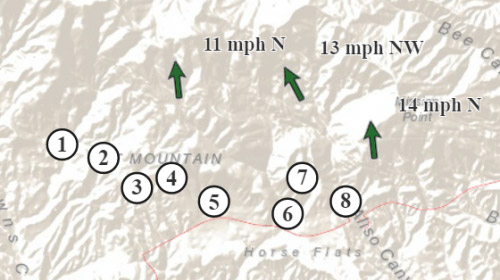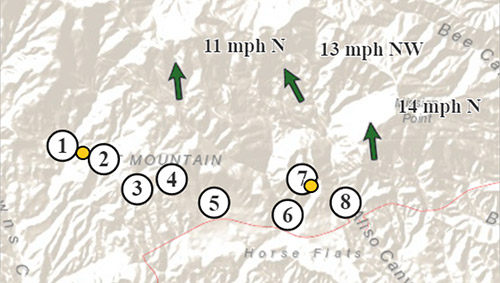
About The Infrared Fence-Line Methane Monitoring System
The Infrared Fence-Line Methane Monitoring System is part of a suite of advanced monitoring technologies and practices at the Aliso Canyon natural gas storage facility.
These technologies include:
- An infrared fence-line methane monitoring system
- Around-the-clock pressure monitoring of all wells in a 24-hour operations center
- Daily patrols to examine every well are conducted four times each day
- Enhanced training for our employees and contractors
Methane Monitoring System

The infrared methane monitoring system is composed of eight infrared sensors strategically located near or along the southern border of the facility, or “fence-line.”[1] These sensors are being continuously monitored 24 hours a day, seven days a week by our trained staff.
The eight infrared monitors installed at Aliso Canyon measure the parts per million (ppm) of methane in the air by sending an infrared beam between a sender (1) and receiver (2), as shown in the picture. Methane readings can potentially be impacted by weather conditions, such as rain, fog and dust, that may interrupt the infrared beam.
Current Infrared Methane Monitoring
Frequently Asked Questions
What actions does SoCalGas take if the readings increase?
- If our fence-line system detects levels averaging at or above 8 parts per million for 20 or more minutes, we send out a team of technicians to that site to investigate. The technicians use sensitive hand-held technology that can detect methane at levels below what human senses can detect.
- We investigate because methane readings can potentially be impacted by weather conditions, such as rain, fog, and dust, which may interrupt the infrared beam. A temporary increase in the readings on one monitor may not necessarily mean that elevated levels of methane are present.
- If we do detect any sort of leak or emission, we would begin our normal process to address the leak and appropriately notify agencies and the community.
Why does the system show steady at 2ppm?
- The California Air Resources Board has identified that 1.9 – 2 parts per million (ppm) is the normal background level of methane for the Porter Ranch Area. As such, we can expect that the normal level is what would be detected most of the time.
- Essentially, a flat line at 2 ppm means that the monitors do not detect any methane above normal background levels.
- The South Coast Air Quality Management District (SCAQMD) had previously provided monitoring. Please keep in mind that the SCAQMD monitor used different technology than ours, so the readings may have been varied.
What does it mean when they show 0ppm?
- If the monitor is offline due to maintenance or weather, it will display an “O” on the interactive map and will return a result of zero parts per million (ppm).
- Readings can be impacted by weather conditions, such as rain, fog, high relative humidity, and dust, which may interrupt the infrared beam and cause a monitor to appear offline.
- Fence-Line Monitors are shown in a weather hold mode (“O”) when the relative humidity exceeds 80%. Once the relative humidity returns below 80%, the weather hold mode is released.
Read more FAQs.
[1] This methane monitoring site is maintained and operated by SoCalGas.
Benzene Monitoring System

The benzene monitoring system is composed of two benzene monitors at locations alongside the fence-line methane monitoring system. These monitors activate after the fence-line methane monitoring system exceeds 25 ppm for more than 30 minutes, and then provide continuous monitoring until the methane drops below 25 ppm. In the event that the benzene monitoring identifies concentrations of benzene that exceed a certain warning threshold, SoCalGas will provide residents who have opted to receive notifications with a Prop 65 warning by email or text message. In addition, SoCalGas will post a warning on alisocynalerts.sonomatechdata.com/warnings*.
Sign Up for Prop 65 Warnings*
*By clicking this link, you will leave socalgas.com and transfer directly to the website of a third party which is not part of the Southern California Gas Company.
Report a Natural Gas Leak
If you suspect a natural gas leak, evacuate the area immediately and call us from a safe location: 1-800-427-2200.
Call 911 promptly, from a safe location, if there is damage resulting in a natural gas leak that may endanger life, cause bodily harm, cause property damage, and/or if you are unable to contact SoCalGas for any reason.
California Air Resources Board (CARB)
Methane is measured in parts per million, or ppm. Normal background is approximately 2 ppm as defined by CARB for the Aliso Canyon area. Visit CARB for more information on methane background levels.
Aliso Canyon Community Notifications
View current and past community notifications from SoCalGas.
Community Notification Archive